Anthony Caro
dal 5/6/2013 al 26/7/2013
Segnalato da
5/6/2013
Anthony Caro
Gagosian Gallery, London
Steel pipes, beams, disks, and agricultural tools make up Caro's latest abstract sculptures, which reveal fresh aspects from every viewpoint. The works evolved out of the planning process for an enormous public sculpture he envisioned for a busy thoroughfare in New York City, and as such are prompted by a sense of ground-parallel speed.

One of the most important things about sculpture is the way in which the viewer is invited to look at it. Whether s/he looks up, walks around it, whether it corkscrews like a Michelangelo or moves around like a Brâncusi-the way in which it would be seen was governing how I approached the sculpture for Park Avenue.
--Anthony Caro
Gagosian Gallery is pleased to present Anthony Caro's Park Avenue sculpture series. This is his first exhibition with the gallery.
Steel pipes, beams, disks, and agricultural tools make up Caro's latest abstract sculptures, which reveal fresh aspects from every viewpoint. The works evolved out of the planning process for an enormous public sculpture he envisioned for a busy thoroughfare in New York City, and as such are prompted by a sense of ground-parallel speed. The long, low pipes of Clouds, for example, create a latitudinal setting for smaller, curved parts that evoke lighter forms moving through space. Solitude is composed of curved and crumpled steel sheets that seem to float around an upright, cannon-like component. Art historian Michael Fried describes the Park Avenue sculptures as "conspicuously open," an apt characterization given the exciting dynamism they achieve with few parts.
When Caro was invited to make a proposal for the Park Avenue public sculpture program, he considered the fact that most viewers would be traveling in cars, buses, or on foot. After at least two years of planning and multiple trips to New York, this ambitious project was canceled for financial reasons. Realizing that the structural sections he had designed to make up the larger work could become captivating forms in their own right, Caro used them as starting points for the present sculptures. In his introductory catalogue essay, Michael Fried writes about these sculptures: "My own impulse had been to think of late Beethoven, the great quartets..." They come across as both straightforward and intensely lyrical.
Caro's initial breakthrough took place in the early 1960s with a series of large, brightly painted steel abstract sculptures, which he placed directly on the floor. At the time it was a radical presentation. This constant reinvention of the language of abstract sculpture, as well as his influential teaching career at St. Martin's School of Art, have distinguished Caro not only as the sculptural successor to artists such as Henry Moore and David Smith, but also as an innovative artist who has consistently defied convention.
Sir Anthony Caro was born in Surrey, England in 1924, and lives and works in London. His work has been shown and collected by museums throughout the world. Major museum exhibitions include "New Sculpture 1960-1963," Whitechapel Art Gallery, London (1963); "Anthony Caro: A Retrospective," The Museum of Modern Art, New York (1975, traveled to Walker Art Center, Minneapolis, Museum of Fine Arts, Houston, and Museum of Fine Arts, Boston); "Anthony Caro," Museum of Contemporary Art, Tokyo (1995); "Anthony Caro," Tate Britain, London (2005); and "Anthony Caro on the Roof," Metropolitan Museum of Art, New York (2011). He was knighted in 1987 and received the Order of Merit in May 2000.
The exhibition is accompanied by a fully illustrated catalogue with an essay by art critic and historian, Michael Fried.
Image: ANTHONY CARO, Torrents, 2012, Steel, rusted, 96 1/8 x 126 x 70 1/8 inches (244 x 320 x 178 cm) © Barford Sculptures Ltd.
For further information please contact the gallery at london@gagosian.com or at +44.207.841.9960.
Opening 6 june 6-8pm
Gagosian Gallery
6-24 Britannia Street, London
Hours: Tue-Sat 10-6
Admission free



